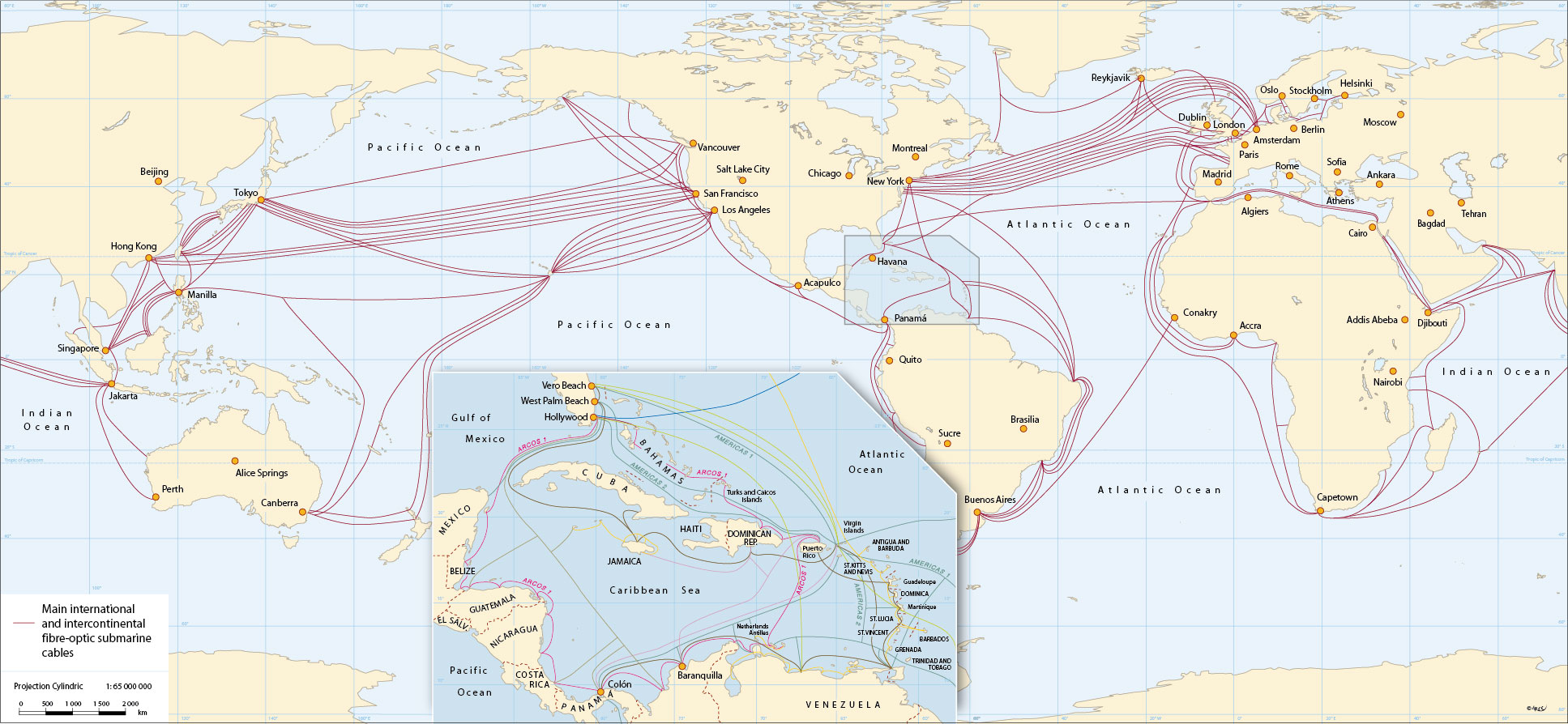
- Air Services in the Caribbean Basin: Continuity and Change
- Air transport (2007-2011): passengers & freight
- Communication technologies (2000)
- Espaces portuaires et maritimes FR
- Impact of containerisation on ports
- Kingston Freeport, port jamaïcain ou port chinois ? FR
- Les ports caribéens : reconfiguration de la géographie portuaire – 2019 FR
- Panama Canal
The last years of the 20th century marked a change of era. Ways of working, of communicating, were radically transformed. One of the defining traits of this change is the role of the information revolution in the activities of millions of the world's inhabitants. The era of information has redrawn the socio-economic map: the Caribbean may define itself as even more marginalized, or on the contrary could derive some advantage to overcome the handicaps of the past. Intercontinental telecommunication flows have undergone exponential growth.
By the end of 2000, the available, accumulated capacity of transatlantic cables represented 1 427 gigabits/s. The global connections of the Caribbean within the telecommunications systems follow a logic determined by both its history and its geography: the Archipelago and its surrounding margins lie astride the links between the United States, Europe, and South America. In themselves the markets are small, but they are integrated within a distribution network rationale, giving access to a vast global market.
Amongst the many providers, the established giant of the internal US market, ATT is obviously present, alongside Cable and Wireless, a British company which serve most of the islands of the Archipelago. In addition to the older cables, such as Key West – Havana, decommissioned in 1989 after 30 years of service, and the infrastructure installed in the 1990s linking Jamaica to the Bahamas, Florida to the Virgin Islands or to Puerto Rico, a number of new lines were open in 2000: Americas 2, across 8 000 km from Hollywood (Florida) to Fortaleza in Brazil, via the US Virgin Islands, Puerto Rico, Martinique, Curacao, Venezuela, Trinidad, and French Guyana; Arcos 1 (American Region Caribbean Ring system), from Hollywood (Florida) to San Juan, Puerto Rico.
The basic structure of these provider networks is organized around two 'hubs,' to adopt the image of the American air traffic system: Florida and Puerto Rico, advanced positions of the United States. Other links do exist, but the essential web remains that routed via Florida – Puerto Rico – coastal surrounds of the Basin – Archipelago, 'en route' to South America. At the end of the 1990s, Puerto Rico initiated a programme putting in place a broad band fibre optic network linking up industrial enterprises and university sites.
Information and communication technologies (ITC) can allow the islands of the Archipelago to break free from the obstacles and handicaps presented by sea and distance. Two possibilities suggest themselves: remote provision of services of low added-value, or inversely the development of niches of competitive activity on a Caribbean scale. It is the latter path that Puerto Rico has now embarked on, bearing in mind that the country benefits by some 11 billion US dollars per annum of financial support from the United States. A campaign was launched in 1999 to transform the island into a global centre of science and technology, and to confirm its position as the commercial bridge between South and North America. Beyond Puerto Rico, the ITCs represent an asset for the Caribbean Islands. Newly emerging resources may well grow in strength, the Caribbean could thereby again assume the role of a 'cross-roads,' a junction point.
top
|
  |













